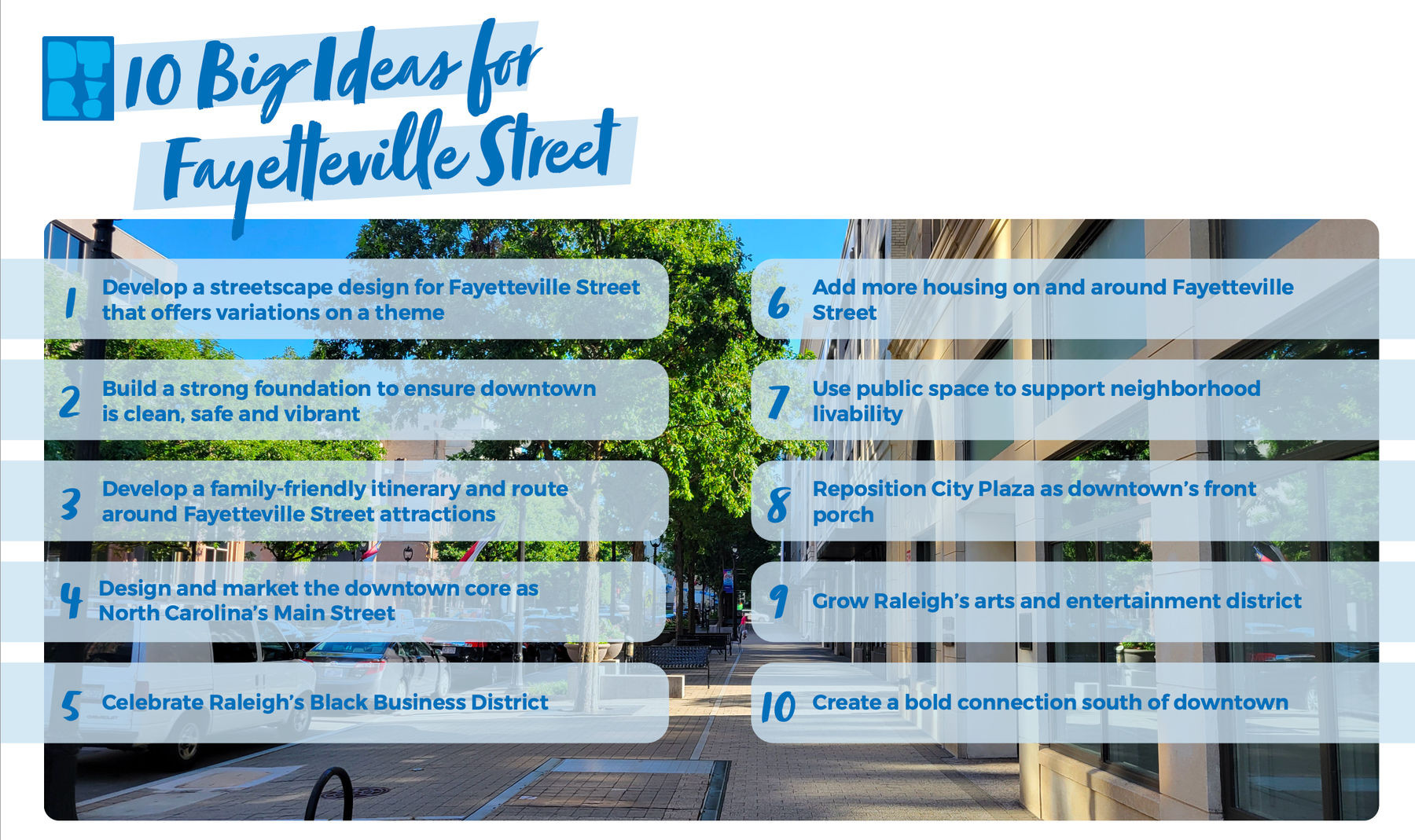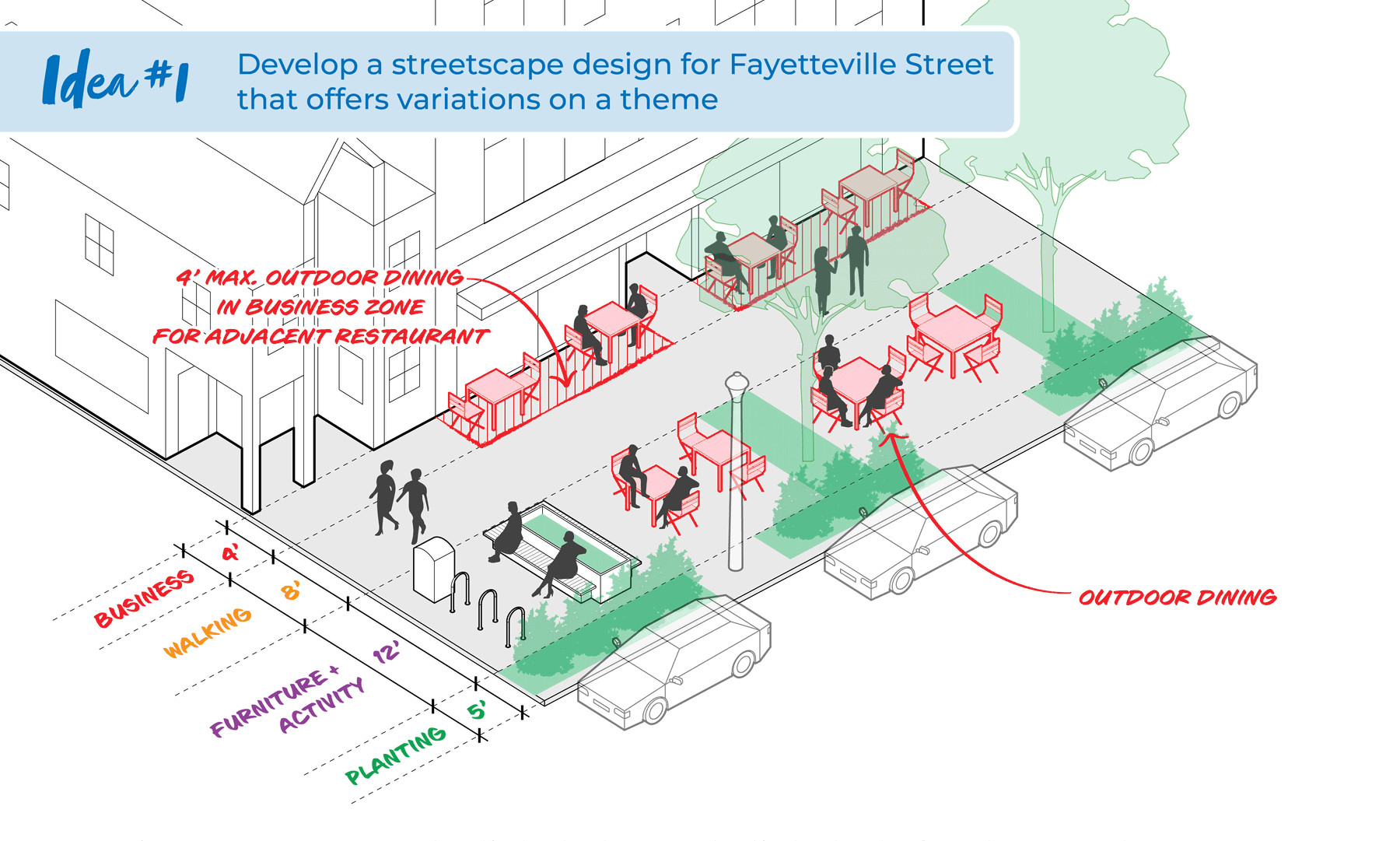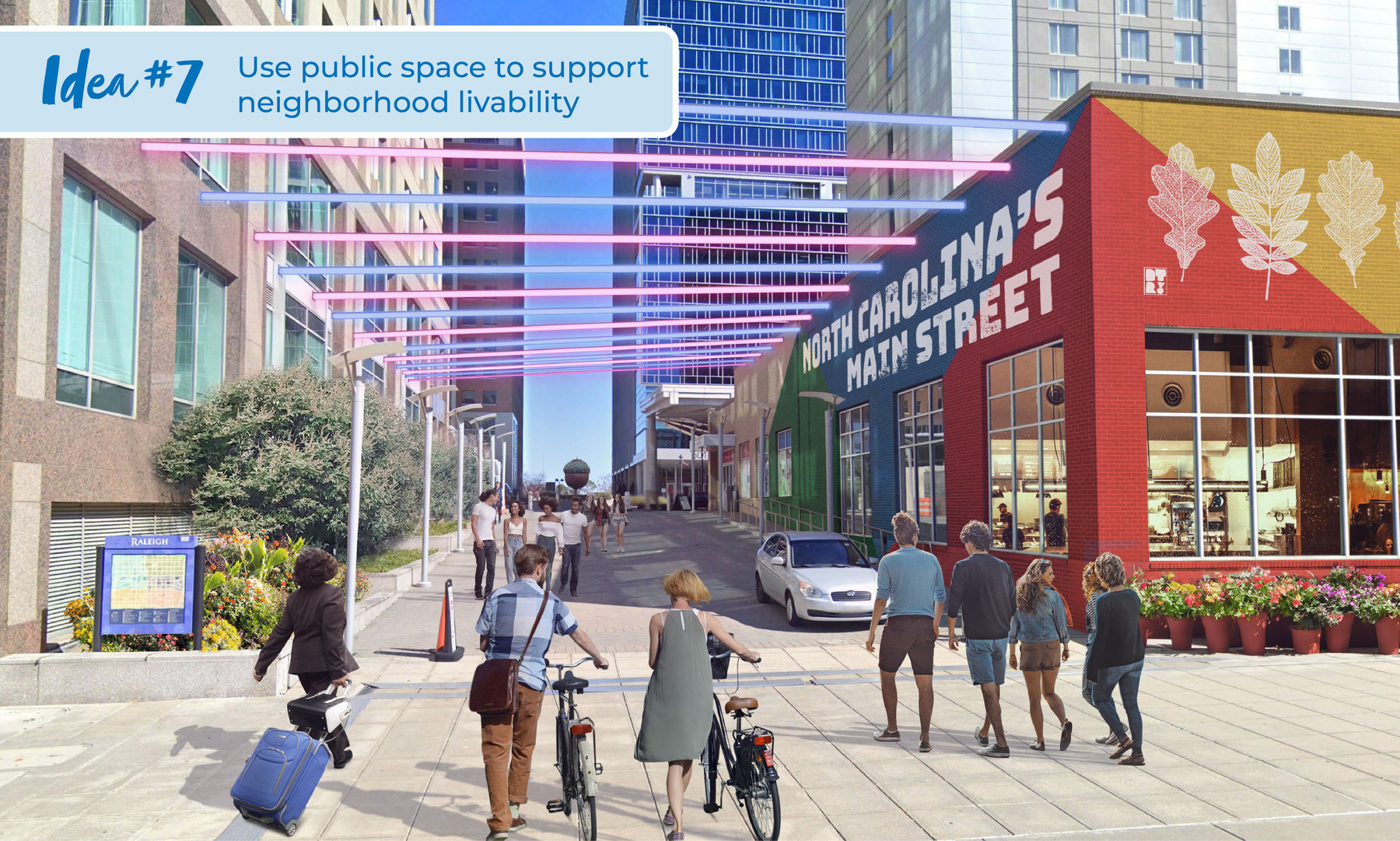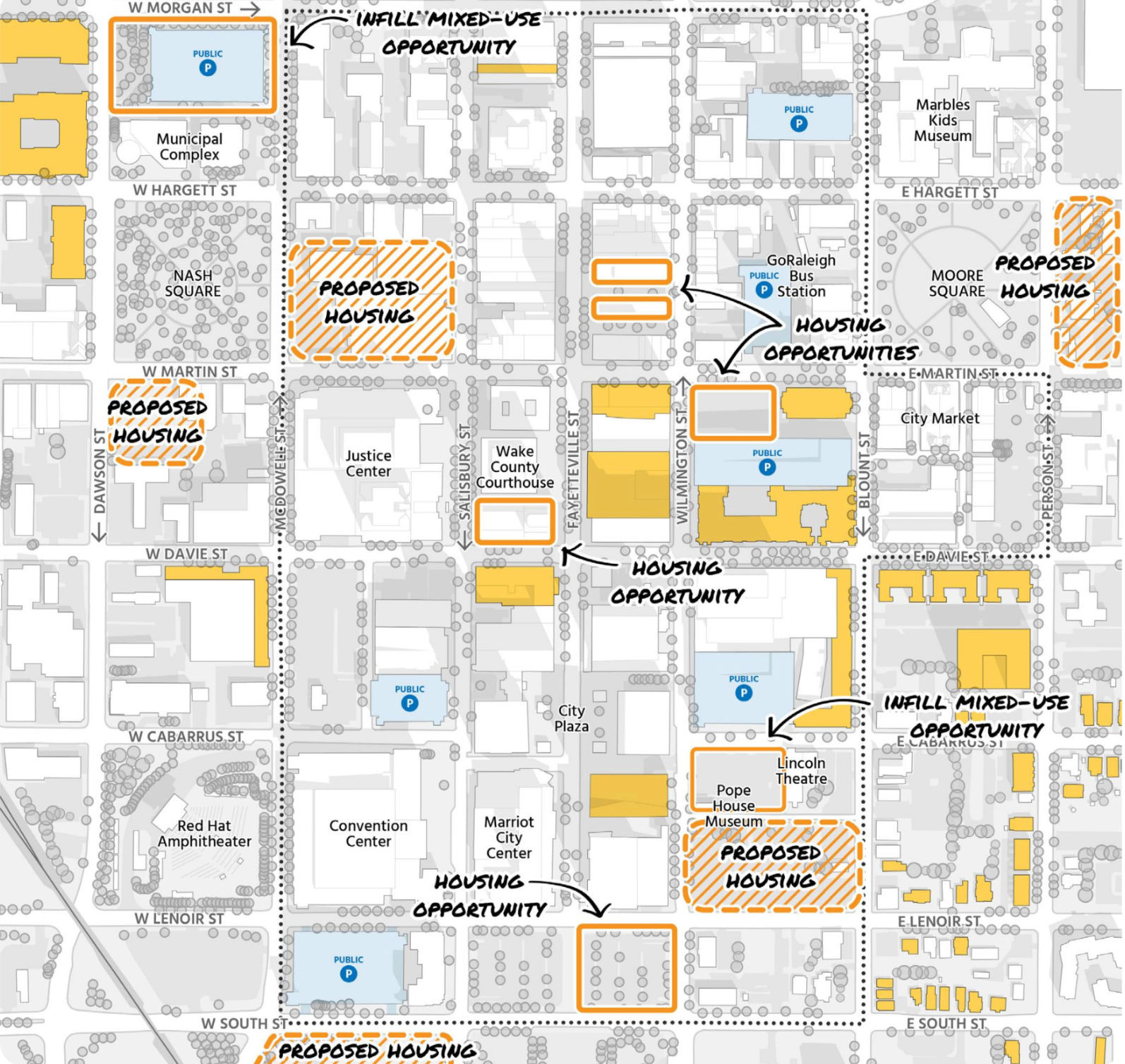The Downtown Raleigh Alliance (DRA) and the City of Raleigh have unveiled the initial recommendations from their collaborative Downtown Raleigh Economic Development Strategy, spearheaded by Interface Studio. These first proposals spotlight Fayetteville Street, recognizing its pivotal role in the city’s core.

As the central thoroughfare of downtown Raleigh and a significant hub for North Carolina, a vibrant Fayetteville Street is crucial. Its revitalization is seen as a catalyst for the broader downtown area, especially as it adapts to the evolving landscape post-pandemic.
The initial ten recommendations are specifically designed to invigorate Fayetteville Street. A comprehensive report detailing these recommendations is available for review. For a broader understanding of the Economic Development Strategy project, please visit the project webpage.
The community is invited to share feedback on these draft recommendations through an online form.
This phase of the Economic Development Strategy marks its halfway point. Future work will refine the Fayetteville Street recommendations and develop a comprehensive strategy for downtown Raleigh, addressing key areas such as:
- Downtown retail strategy enhancement
- Downtown office market analysis and positioning
- Opportunities for Women- and Minority-owned Businesses improvement
- Development of innovative concepts for Downtown Raleigh’s advancement
Public engagement opportunities will continue in the coming months. Stay informed about the project’s progress by signing up for updates.
Community-Driven Insights
Interface Studio, in partnership with DRA, prioritized community engagement to shape the Economic Development Strategy. Extensive research and community input were gathered to ensure the recommendations align with shared objectives and opportunities for Downtown Raleigh.
This engagement involved direct interviews with key Downtown Raleigh stakeholders, alongside focus groups, public meetings, and pop-up events. Over 65 interviews and focus group sessions facilitated feedback from a diverse cross-section of the community. This valuable input was instrumental in developing robust recommendations aimed at creating a thriving and inclusive Downtown Raleigh for everyone.
 A visual overview of the ten key recommendations for activating Fayetteville Street in Downtown Raleigh.
A visual overview of the ten key recommendations for activating Fayetteville Street in Downtown Raleigh.
Ten Recommendations for Activating Fayetteville Street
The “Activating Fayetteville Street” report proposes ten interconnected recommendations. These ideas aim to revitalize Fayetteville Street and strengthen its connections with surrounding Downtown Raleigh neighborhoods.
Idea #1 – Thematic Streetscape Design for Fayetteville Street
Envisioning Fayetteville Street as the green heart of Downtown Raleigh and a welcoming gateway to North Carolina, the strategy emphasizes a vibrant and inviting atmosphere. This concept aims to attract visitors and seamlessly connect neighboring areas. Proposed streetscape enhancements include upgraded seating arrangements, adaptable spaces for events and recreational activities, and clearly defined zones for commercial use, enhancing the pedestrian experience along Fayetteville Street.
 Conceptual sidewalk module designs for Fayetteville Street, showcasing flexible space for seating and activation in Downtown Raleigh.
Conceptual sidewalk module designs for Fayetteville Street, showcasing flexible space for seating and activation in Downtown Raleigh.
Idea #2 – Prioritizing Cleanliness, Safety, and Vibrancy
Recognizing safety as a fundamental element of a thriving downtown, the recommendations stress the importance of a well-maintained public realm. Street upkeep, sidewalk quality, and landscaping are identified as key contributors to the perception of safety. Improving the visitor experience through a focus on these aspects will create positive impressions, generate positive word-of-mouth, and encourage repeat visits to Fayetteville Street and Downtown Raleigh.
Idea #3 – Family-Friendly Fayetteville Street Itinerary
Downtown Raleigh boasts numerous attractions; however, their connectivity can be improved. By creating stronger links between these attractions and surrounding business districts and residential neighborhoods, and by curating family-oriented activities, Fayetteville Street can become a destination for memorable experiences. Developing a family-friendly itinerary around Fayetteville Street attractions will encourage families to spend more time downtown, benefiting local businesses and the community.
Idea #4 – Branding Downtown Raleigh as “North Carolina’s Main Street”
To enhance downtown Raleigh’s appeal, the strategy suggests marketing the downtown core as “North Carolina’s Main Street”. Concentrating retail and restaurant offerings around a “Best in North Carolina” theme, complemented by engaging public space design, aims to draw more people to the area. Strategic reinvestment and support for current and future businesses, coupled with a unique district identity, will make downtown, particularly Fayetteville Street, more attractive to both residents and tourists.
 A daytime rendering of City Plaza as a welcoming gateway, part of the initiative to brand Downtown Raleigh as “North Carolina’s Main Street.”
A daytime rendering of City Plaza as a welcoming gateway, part of the initiative to brand Downtown Raleigh as “North Carolina’s Main Street.”
Idea #5 – Celebrating Raleigh’s Black Business District
The strategy recognizes the importance of Raleigh’s Black Business District and proposes enhancing its integration within Downtown Raleigh. Increased visibility for Black-owned businesses, storytelling through public art installations, and placemaking events are recommended to honor the district’s rich legacy and create an environment for these businesses to prosper along Fayetteville Street and the surrounding areas.
Idea #6 – Increasing Housing Density on and Near Fayetteville Street
Despite significant residential development in Downtown Raleigh since 2020, most new units are not located directly on or near Fayetteville Street. The recommendations advocate for strategic redevelopment along Fayetteville Street to encourage mixed-use developments. Attracting businesses like coffee shops that complement residential density, and addressing parking considerations, can foster a balanced mix of residents, workers, and visitors, supporting businesses throughout the Fayetteville Street corridor.
 A map illustrating residential development areas in Downtown Raleigh, highlighting opportunities for increased housing near Fayetteville Street.
A map illustrating residential development areas in Downtown Raleigh, highlighting opportunities for increased housing near Fayetteville Street.
Idea #7 – Leveraging Public Spaces for Neighborhood Livability
The strategy emphasizes the role of attractive and functional public spaces in enhancing downtown livability. Exploring the use of lighting, public art, and creative wayfinding to connect downtown to surrounding neighborhoods is a key component. Additionally, the plan considers creating flexible public spaces capable of accommodating both large and small-scale events for residents and businesses, further activating Fayetteville Street and adjacent areas.
Idea #8 – Repositioning City Plaza as Downtown’s “Front Porch”
City Plaza holds the potential to become the vibrant heart of Downtown Raleigh. While designed for large events, its daily appeal can be enhanced. Strategic investments are proposed to transform City Plaza into a welcoming “front porch” for residents and visitors. This reimagining aims to showcase the city’s offerings, from food and beverages to artisanal goods and entertainment, creating a more inviting space connected to Fayetteville Street.
 An aerial view of City Plaza, illustrating its potential as a revitalized public space and “front porch” for Downtown Raleigh.
An aerial view of City Plaza, illustrating its potential as a revitalized public space and “front porch” for Downtown Raleigh.
Idea #9 – Expanding Raleigh’s Arts and Entertainment District
To solidify Downtown Raleigh’s reputation as an arts and entertainment destination, the strategy recommends leveraging larger-scale development opportunities. Building custom spaces for destination entertainment venues and unique restaurant concepts within the Fayetteville Street area will attract visitors and workers alike, enriching the cultural landscape of the city center.
Idea #10 – Creating Stronger Connections South of Downtown
Significant investments are underway south of downtown, including Dix Park, Heritage Park, and mixed-use developments. The strategy underscores the importance of establishing robust connections not only between Dix Park and the downtown core, but also to neighborhoods and destinations along the way. This enhanced connectivity will extend the vibrancy of Fayetteville Street and downtown Raleigh into the surrounding areas.
 A map outlining planned developments south of Downtown Raleigh, emphasizing the need for enhanced connectivity to Fayetteville Street and the downtown core.
A map outlining planned developments south of Downtown Raleigh, emphasizing the need for enhanced connectivity to Fayetteville Street and the downtown core.
These ten recommendations are rooted in fostering a culture of innovation and adaptability. This approach aims to cultivate dynamism and activity along Fayetteville Street while seamlessly integrating the district with Downtown Raleigh’s broader amenities, neighborhoods, and cultural institutions.
The project is currently in its mid-phase, with ongoing efforts to refine these recommendations and build momentum for implementation. This spring, the DRA and consultant team will continue to engage stakeholders to define next steps in key areas such as office space, retail, MWBE (Minority and Women-Owned Business Enterprises) support, and catalytic projects.
Full Report | Part 1: Activating Fayetteville Street
Published February 8th, 2024
Download Compressed Report
Provide your feedback on the draft recommendations by completing the form below.
Provide Feedback on the Report
The comprehensive Downtown Raleigh Economic Development Strategy, anticipated in mid-2024, will serve as a guide and toolkit for the community. It will pave the way for a vibrant and thriving Downtown Raleigh that continues to grow and exceed expectations. The DRA team is dedicated to leading this initiative, confident that collaborative community efforts will shape a future for Downtown Raleigh that surpasses even the most ambitious visions.
View Overall Strategy Webpage

